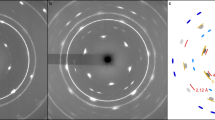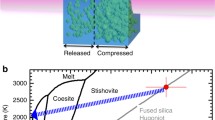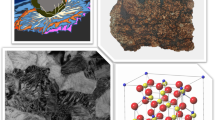Abstract
Shock experiments on quartz single crystals with initial temperatures −170 to +1000°C showed that ambient temperature does not affect the type of defects formed but can lower the pressure of complete amorphization. The amount of glass recovered increases with both pressure and temperature, and the shock-induced phase transformation of quartz is temperature-activated with an apparent activation energy of <60 kJ/ mol. The phase transformation is localized along three types of transformation lamellae (narrow, s-shaped, and wide) which contain fractured and/or high-pressure phases. Transformation lamellae are inferred to form by motion of linear collapse zones propagating near the shock front. Equilibrium phases, such as stishovite, were not recovered and are probably not formed at high shock pressures: the dominant transformation mechanism is inferred to be solid-state collapse to a dense, disordered phase. Melting occurs separately by friction along microfaults, but no high-pressure crystal phases are quenched in these zones. Shock of quartz thus produces two types of disordered material, quenched melt (along microfaults) and diaplectic glass (in transformation lamellae); the quenched melt expands during P-T release, leaving it with a density lower than quartz, while recovered diaplectic glass has a density closer to that of quartz. At low pressures (< 15 GPa), quartz transforms mostly by shear melting, while at higher pressures it converts mostly along transformation lamellae. We find that shock paleopiezometers using microstructures are nominally temperature-invariant, so that features observed at impact craters and the K/T boundary require in excess of 10 GPa to form, regardless of the target temperature. Shock comminution will be much more extensive for impacts on cold surfaces due to lack of cementation of fragments by melt glass; shock on hot surfaces could produce much more glass than estimated from room-temperature experiments. Because of the shock-impedance mismatch between quartz specimen and steel capsule, the incident shock wave reverberates up to a final pressure. The dynamic compression process is quasi-isentropic with high strain rates. Preheating and precooling achieves final shock pressures and temperatures representative of single-shock states of room temperature quartz and of quartz on known planetary surfaces. Stress histories were calculated by detailed 1- and 2-dimensional computer simulations. The stress history throughout the sample is relatively uniform, with minor variations during unloading. Significant differences between impact pressures calculated by the shock-impedance-match method and specimen pressures calculated by computer simulations indicate the importance of modeling shock recovery experiments computationally.
Similar content being viewed by others
References
Ahrens TJ, Rosenberg T (1968) Shock metamorphism: experiments on quartz and plagioclase. Shock Metamorphism of Natural Materials. In: French BM, Short NM (eds). Baltimore, Mono Book Corp, pp 59–81
Ahrens TJ, Lyzenga GA, Mitchell AC (1982) Temperatures induced by shock waves in minerals: Applications to geophysics. High Pressure Research in Geophysics. In: Akomoto S, Manghnani MH (eds) Center for Academic Publications, Tokyo:579–594
Akaogi M, Navrotsky A (1984) The quartz-coesite-stishovite transformations: new calorimetric measurements and calculation of phase diagrams. Phys Earth Planet Inter 362:124–134
Akashi T, Sawaoka A, Saito S (1977) Effect of multiple shock-compressions on the structural changes of boron nitride. Research Laboratory of Engineering Materials, Tokyo Institute of Technology Rep, pp 134–142
Al'tshuler LV, Trunin RF, Simakov GV (1965) Shock compression of periclase and quartz and composition of the lower mantle of the Earth. Bull Acad Sci USSR, Earth Physics (Izv.). (10): 657
Alam M, DebRoy T, Roy R, Roy BE (1988) High-pressure phases of SiO2 made in air by Fedoseev-Derjaguin laser process. Appl Phys Lett 53(18):1687–1689
Anan'in AV, Breusov ON, Dremin AN, Pershin SV, Tatsii VF (1974) The effect of shock waves on silicon dioxide. I. Quartz. Fiz Goren Vzryva 10(3):426–436
Arndt J (1984) Shock isotropization of minerals. Shock Waves in Condensed Matter — 1983. Elsevier, North-Holland, pp 473–480
Ashworth JR, Schneider H (1985) Deformation and transformation in experimentally shock-loaded quartz. Phys Chem Minerals 11:241–249
Binggeli N, Chelikowsky JR (1991) Structural transformation of quartz at high pressures. Nature 353:344–346
Breval E, Alam M, Kwan S, Grutzeck M (1992) High pressure phase transformations observed in silica glass disks after treatment with a CO2 laser (submitted)
Brannon PJ, Konrad CH, Morris RW, Jones ED, Asay JR (1983) Spectral and spatial studies of shock-induced luminescence from quartz. Sandia Rept. SAND82-2469:85
Brannon PJ, Morris RW, Konrad CH, Asay JR, Straub GK (1984) Shock-induced luminescence from x-cut quartz and z-cut lithium niobate. Shock Waves in Condensed Matter — 1983
Carter NL (1965) Basal quartz deformation lamellae — a criterion for recognition of impactites. Am J Sci 263:786–806
Chelikowsky JR, King HEJ (1990) Structural properties of α-quartz near the amorphous transition. Phys Rev Lett 65(26):3309–3312
Chhabildas LC, Grady DE (1984) Dynamic material response of quartz at high strain rates. Mater. Res. Soc. Symp. 22. In: Homan C, MacCrone RK, Whalley E (eds). Elsevier, North Holland, pp 147–151
Chhabildas LC (1986) Shock loading and release behavior of x-cut quartz. Shock Waves in Condensed Matter. Gupta YM (ed) Plenum Press, New York, pp 601–605
Chao ECT, Shoemaker EM, Madsen BM (1960) First natural occurrence of coesite. Science 133:882–883
Chao ECT, Fahey JJ, Littler J, Milton DJ (1962) Stishovite, SiO2, a very high pressure new mineral from Meteor Crater, Arizona. J Geophys Res 67(1):419–421
Cygan RT, Boslough MB, Kirkpatrick RJ (1990) NMR spectroscopy of experimentally shocked quartz: shock wave barometry. Proc Lunar Planet Sci Conf XX: 451–457
Cygan RT, Boslough MB, Kirkpatrick RJ (1992) NMR spectroscopy of experimentally shocked quartz and plagioclase feldspar powders Proc Lunar Planet Sci Conf XXII: 127–136
De Carli PS, Jamieson JC (1959) Formation of an amorphous form of quartz under shock conditions. J Chem Phys 31(6):1675–1677
Dence MR (1968) Shock zoning at Canadian craters: petrography and structural implications. Shock Metamorphism of Natural Materials. In: French BM, Short NM (eds). Baltimore, MD, Mono Book Corp:169–184
Durben DJ, Wolf GH (1991) Raman spectroscopic study of the pressure-induced coordination change in GeO2 glass. Phys Rev B 43(3):2355–2363
Fowles R (1967) Dynamic compression of quartz. J Geophys Res 72(22):5729–5742
Frondel C (1962) The System of Mineralogy III. Silica Minerals. New York, Wiley
Fujii Y, Kowaka M (1985) The pressure-induced metallic amorphous state of SnI4: I. A novel crystal-to-amorphous transition studied by x-ray scattering. J Phys C 18:789–797
German VN, Podurets MA, Trunin RF (1973) Synthesis of a high-density phase of silicon dioxide in shock waves. Sov Phys-JETP 37(1):107
Gibbons RV (1974) Experimental effects of high shock pressure on material of geological and geophysical interest. Ph.D. Dissertation, California Institute of Technology
Gibbons RV, Morris RV, Hörz F (1975) Pétrographic and ferromagnetic resonance studies of experimentally shocked regolith analogs. Proc Lunar Planet Sci Conf VI:3143–3171
Goltrant O, Doukhan J-C, Cordier P (1991) Planar features in shocked quartzes: a transmission electron microscopy investigation. Earth Planet Sci Lett 106(1–4):103–115
Grady DE, Murri WJ, Fowles GR (1974) Quartz to stishovite: wave propagation in the mixed phase region. J Geophys Res 29(2):332–338
Grady DE, Murri WJ, DeCarli PS (1975) Hugoniot sound velocities and phase transformations in two silicates. J Geophys Res 80(85):4857–4861
Gratz AJ (1984) Deformation in laboratory-shocked quartz. J Non-Cryst Solids 67:543–558
Gratz AJ, Tyburczy J, Christie J, Ahrens T, Pongratz P (1988a) Shock metamorphism of deformed quartz. Phys Chem Minerals 16:221–233
Gratz AJ, Pongratz P, Preisinger A, Christie JM, Bohor B, Frey I (1988b) Optical microscopy and TEM of shocked materials from the Clear Creek, Colorado K/T ‘magic layer’. Proc Lunar Planet Sci Conf XIX:419–420
Gratz AJ, Coffey DW, Allard L (1991) Hydrothermal etching of quartz: observations and theory (in preparation)
Grieve RAF, Sharpton VL, Stöffier D (1990) Shocked minerals and the K/T controversy. Eos 71(46):1792
Grieve RAF, Robertson PB (1976) Variations in shock deformation at the Slate Islands impact structure, Lake Superior, Canada. Contrib Mineral Petrol 58:37–49
Gustavsen R, Gupta YM (1991) Time-resolved Raman measurements in α-quartz shocked to 60 kbar along the z axis. Am Phys Soc Bull 36(6):1821
Hazen RM, Finger LW (1989) High-pressure crystal chemistry and amorphization of α-quartz. Solid State Commun 72(5):507–511
Hemley RJ, Jephcoat AP, Mao HK, Ming LC, Manghnani MH (1988) Pressure-induced amorphization of crystalline silica. Nature 334(6177):52–54
Heuer AJ, Lally JS, Christie JM, Radcliffe SV (1972) Phase transformations and exsolution in lunar and terrestrial calcic plagioclase. Philos Mag 26:265–281
Hobbs BE (1968) Recrystallization of single crystals of quartz. Tectonophys 6(5):353–401
Hörz F (1968) Statistical measurements of deformation structures and refractive indices in experimentally shock loaded quartz. Shock Metamorphism of Natural Materials. In: French BM, Short NM (eds). Baltimore, MD, Mono Book Corp:23–54
Jakubith M, Lehmann G (1979) An EPR study of shock-wave effects on amethyst and iron-doped quartz. Ber Bunsenges Phys Chem 83:609–614
Jakubith M, Lehmann G (1981) An X-ray photoelectron spectroscopic study of shock-loaded quartz. Phys Chem Minerals 7:165–168
Jeanloz R (1980) Shock effects in olivine and implications for hugoniot data. J Geophys Res 85(B6):3163–3176
Kieffer SW, Phakey PP, Christie JM (1976) Shock processes in porous quartzite: transmission electron microscope observations and theory. Contrib Mineral Petrol 59:41–93
Kitamura M, Goto T, Syono Y (1977) Intergrowth textures of diaplectic glass and crystal in shock-loaded P-anorthite. Contrib Mineral Petrol 61:299–304
Kleeman JD, Ahrens TJ (1973) Shock-induced transition of quartz to stishovite. J Geophys Res 78(26):5954–5960
Kondo K-I, Soga S, Sawaoka A, Araki M (1985) Shock compaction of silicon carbide powder. J Mater Sci 20:1033–1048
Kruger MB (1990) Memory glass: an amorphous material formed from A1PO4. Science 249:647–649
Levien L (1980) Structure and elastic properties of quartz at pressure. Am Mineral 65:920–930
Lyzenga GA, Ahrens TJ (1980) Shock temperature measurements in MgSiO4 and SiO2 at high pressures. Geophys Res Lett 7:141
Lyzenga GA, Ahrens TJ (1983) Shock temperatures of SiO2 and their geophysical implications. J Geophys Res 88(3):2431–2444
Mashimo T, Nishii K, Soma T, Sawaoka A (1980) Some physical properties of amorphous SiO2 synthesized by shock compression of a quartz. Phys Chem Minerals 5:367–377
McLaren AC, Retchford JA, Griggs DT, Christie JM (1967) Transmission electron microscope study of Brazil twins and dislocations experimentally produced in natural quartz. Phys Status Solidi 19:631–644
McNeil LE, Grimsditch M (1992) Pressure-amorphized SiO2 α-quartz: An anisotropic amorphous solid. Phys Rev Lett 68(1):83–85
McQueen RG, Fritz JN, Marsh SP (1963) On the equation of state of stishovite. J Geophys Res 68(8):2319–2322
McQueen RG (1991) The velocity of sound behind strong shocks in SiO2. Am Phys Soc Bull 36(6):1850
Miura Y (1991) Evidence for shock wave effect of meteoritic impact. Shock Waves 1:35–41
Müller WF, Defourneaux M (1968) Deformationsstrukturen in Quarz als Indikator für Stoßwellen: eine experimentelle Untersuchung an Quarz-Einkristallen. Z Geophys 34(5):483–504
Neumeier JJ, Nellis WJ, Maple MB, Torikachvili MS, Yang KN, Ferreira JM, Summers LT, Miller JI, Sales BC (1989) Metastable A15 phase Nb3Si synthesized by high dynamic pressure. High Press Res 1:267–289
Ng A, Godwal BK (1991) Nonequilibrium shock behavior in quartz. Phys Rev B 44(10):48726
Podurets MA, Popov LV, Sevast'yanova AG, Simakov GV, Trunin RF (1977) On the relation between the size of studied specimens and the position of the silica shock adiabat. Phys Solid Earth (12): 11
Rustad JR, Yuen DA, Spera FJ (1990) Molecular dynamics of liquid SiO2 under high pressure. Phys Rev A 42(4):2081–2089
Rustad JR, Yuen DA (1991) The sensitivity of physical and spectral properties of silica glass to variations of interatomic potentials under high pressure. Phys Earth Plan Inter 65:210–230
Sawai S, Kondo K (1988) Characterization of the grain boundary in shock-compacted diamonds. J Am Ceram Soc 71(4):C185–188
Schaal RB, Hörz F (1977) Shocked rutilated quartz. Eos 68:1455
Schneider H, Hornemann U (1976) X-ray investigations on the deformation of experimentally shock-loaded quartzes. Contrib Mineral Petrol 55:205–215
Seaman CL, Weir ST, Early EA, Maple MB, Nellis WJ, McCandless PC, Brocious WF (1990) Crystallographically oriented superconducting Bi2Sr2CaCu2O8 by shock compaction of prealigned powders. Appl Phys Lett 57(1):93–95
Stixrude L, Bukowinski MST (1989) Compression of tetrahedrally bonded SiO2 liquid and silicate liquid-crystal density inversion. Phys Rev B 16(12):1403–1406
Stixrude L, Bukowinski MST (1991) Atomic structure of SiO2 glass and its response to pressure. Geophys Res Lett 44(6):2523–2534
Stöffier D, Hornemann U (1972) Quartz and feldspar glasses produced by natural and experimental shock. Meteoritics 7(3):371–394
Swegle JW (1989) Irreversible phase transitions and wave propagation in silicate geologic materials. Sandia Nat' Lab Tech Kept SAND89-1443
Swegle JW (1990) Irreversible phase transitions and wave propagation in silicate geologic materials. J Appl Phys 68(4):1563–1579
Tan H, Ahrens TJ (1990) Shock induced polymorphic transition in quartz, carbon, and boron nitride. J Appl Phys 67(1):217–224
Tattevin H, Syono Y, Kikuchi M, Kusaba K, Velde B (1990) Shock deformation of alpha quartz: laboratory experiments and TEM investigation. Eur J Mineral 2:227–234
Trunin RF, Simakov GV, Podurets MA, Moiseyev BN, Popov LV (1970) Dynamic compressibility of quartz and quartzite at high pressure. Izv (Earth Physics) 1:13–20
Tse JS, Klug DD (1991) Mechanical instability of α-quartz: A molecular-dynamics study. Phys Rev Lett 67(25):3559–3562
Tsuchida Y, Yagi T (1990) New pressure-induced transformations of silica at room temperature. Nature 347:267–269
Tullis J, Tullis T (1972) Preferred orientation of quartz produced by mechanical Dauphine twinning: thermodynamics and experiments. Flow and Fracture of Rocks. Geophys. Monogr. 16. In: Heard HC, Borg IY, Carter NL, Raleigh CB (eds). AGU: 67–82
Tullis J, Yund RA (1982) Grain growth kinetics of quartz and calcite aggregates. J Geol 90:301–318
Tyburczy JA, Frisch B, Ahrens TJ (1986) Shock-induced volatile loss from a carbonaceous chondrite: implications for planetary accretion. Earth Planet Sci Conf 80(34):201–207
Wackerle J (1962) Shock-wave compression of quartz. J Appl Phys 33:922–937
Walzebuck JP, Engelhardt W v (1979) Shock deformation of quartz influenced by grain size and shock direction: observations on quartz-plagioclase rocks from the basement of the Ries Crater, Germany. Contrib Mineral Petrol 70:267–271
Weir ST, Nellis WJ, Seaman CL, Early FA, Maple MB, Kikuchi M, Syono Y (1991) Shock consolidation of crystallographically aligned Bi2Sr2CaCu2O8 powders (submitted)
Williams Q, Jeanloz R (1988) Spectroscopic evidence for pressure-induced coordination changes in silicate glasses and melts. Science 239:902–905
Wolfe SH, Hörz F (1970) Shock effects in scapolite. Am Mineral 55:1313–1328
Xue X, Stebbins JF et al. (1989) Silicon coordination changes in a silicate liquid at high pressures. Science 245:96204
Author information
Authors and Affiliations
Rights and permissions
About this article
Cite this article
Gratz, A.J., Nellis, W.J., Christie, J.M. et al. Shock metamorphism of quartz with initial temperatures −170 to + 1000° C. Phys Chem Minerals 19, 267–288 (1992). https://doi.org/10.1007/BF00204005
Received:
Revised:
Accepted:
Issue Date:
DOI: https://doi.org/10.1007/BF00204005




